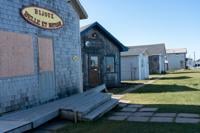Update, May 16, 2024: The municipality has paused implementation of the visitor fee, citing logistical issues.
Quebec’s Îles-de-la-Madeleine, a small archipelago northeast of Prince Edward Island, is introducing a $30 visitor fee called the Passe Archipel and payment will be confirmed through the use of a QR code. Some social media posts claim the fee is linked to 15-minute cities, social credit scores and suggest it could restrict people's freedoms. These claims are misleading. The fee is for travellers who stay on the islands for more than 24 hours between May 1 and Oct. 14 and the QR code does not contain any personal information.
Some posts on X, formerly known as Twitter, and Facebook are claiming the municipality is forcing people to scan a QR code to enter and leave. Some are calling it a "," saying people are trading their private information to leave their communities. say "authorities could selectively restrict individuals' freedom to leave."
Keean Bexte, a well-known social media personality who runs the website The Counter Signal, that"Canada now has a town that forces you to scan a QR code to enter and leave, and then charges you a $30 tax. They told you that 15-minute cities were just for convenience."
At the time of publication, that post had 335,800 views and 3,600 reposts.
Rating: Misleading
The requires that during the busy tourist season, any non-resident aged 13 and over who spends more than 24 hours on the archipelago will have to pay $30 plus taxes, to a maximum of $100 for a family.
People who live in the maritime community do not have to pay. They will have to show they are a resident, through identification such as a driver's licence. People who own a second home in the in the Îles-de-la-Madeleine will receive proof of exemption for the fee by mail or email.
The fee goes to the Fonds de gestion durable du territoire (Sustainable Territory Management Fund). The municipality's website says the fund supports the preservation of the natural environment and helps maintain and develop the region's recreational and tourism infrastructure.
If people don't pay they risk a fine enforceable in municipal court.
'Not a way to control anything'
Îles-de-la-Madeleine Mayor Antonin Valiquette said the QR code works a lot like online ticketing for concerts. Travellers go to a website, buy the pass and receive a payment confirmation in the form of a QR code.
"There's no personal information in the QR code. There's no name, no address, because it's transferable," Valiquette said in an interview with The ��ɫֱ�� Press.
The only information is whether it was paid, he said. The code becomes invalid once it's scanned.
"It's not a way to control anything," the mayor said.
No notes are taken when a resident shows their identification or proof of exemption either, he said.
No connection to 15-minute cities
Valiquette said the pass has nothing to do with 15-minute cities, a conspiracy theory built on the basis that planning easily navigable communities is a plot to restrict mobility rights and create a mass-surveillance state.
"I don't have any clue of what that was before the last few weeks," Valiquette said.
David Roberts, director of the urban studies program and an associate professor at the University of Toronto, said 15-minute cities are not actually about quarantines, lockdowns or other limits of movement. They are about trying to build complete communities, where individuals can get most of their needs met close to home, Roberts said.
The conspiracy connection to this fee is confusing, Roberts said, because it involves islands that require different travel.
Many of the social media posts link to a on April 9 where several people voiced opposition to the visitor fee.
Some residents expressed in the meeting, and later to news organizations, concerns about having to identify themselves to leave their own town. They also said it was unfair to charge mainland Quebecers for using public resources partly financed by the provincial government.
The mayor said people are already showing identification to travel.
Travellers provide identification to get on a plane. If they take a ferry boat to Prince Edward Island they'll be asked to present a confirmation of their reservation to get a boarding pass.
The municipality told in late April it was still developing a plan for how it intends to check QR codes or identification.
Other places have different types of tourism fees
Îles-de-la-Madeleine has a year-round population of about 13,000 residents. The area gets around 60,000 visitors during the tourist season who stay on average 10 days.
Valiquette said it takes a toll on infrastructure.
"All that has a cost," he said. "Until now there was only citizens that paid for it via their taxes."
The mayor pointed to the Galápagos Islands, an archipelago in the Pacific Ocean, which recently for most foreign tourists to US$200 (about C$275). About 30,00 people live on one of the islands, but around 170,000 tourists visit in a typical year, according to . The entrance fee goes to conservation efforts and supporting local services.
While Îles-de-la-Madeleine's move is not common in Canada, extra costs on hotels are. For example, Alberta imposes a of four per cent of the purchase price of accommodation. The has a mandatory municipal accommodation tax of $2 a night.
An additional was brought in for Vancouver hotels, Airbnb's and other vacation rentals to help raise revenue for the 2026 FIFA World Cup and the expected surge of visitors. The temporary major events tax began in 2023 and will stay in place until 2030.
Roberts from U of T said when tourism fees are tied to the cost of the hotel, travellers don't think much about it. In Îles-de-la-Madeleine there are only a handful of hotels and many tourists stay in cottages or other non-traditional units, so that could make it more difficult to apply the fees in the same way as other places in Canada.
"Tourists sometimes create a burden on small communities," he said.
It's common around the world for places with a lot of tourists to add extra costs, Roberts said.
Rome charges for non-residents that visitors pay to their hotel or other accommodation. are among other cities with a tourist tax tied to accommodation.
International tourists heading now must pay a tourist tax during their stay after the policy was implemented in the Indonesia hot spot earlier this year.
Sources
Social media claims can be found on X () and (), and on Facebook (, )
()
()
()
()
: ()
Planning a summer trip to Quebec’s Iles-de-la-Madeleine? You’ll have to pay up – The ��ɫֱ�� Press ()
()
()
()
()
()
()
()
()
()
About ��ɫֱ�� Press fact checks
You can find out more about ��ɫֱ��here and about ��ɫֱ�� Press Fact Checks here. To reach our fact-checking team with any tips, corrections or comments, please email us at cpfactcheck@thecanadianpress.com.
Note to readers: This story was updated on May 16, 2024, to replace the photo. An earlier photo incorrectly labelled Bonaventure Island and the Percé rock as part of Îles-de-la-Madeleine, Que.








































